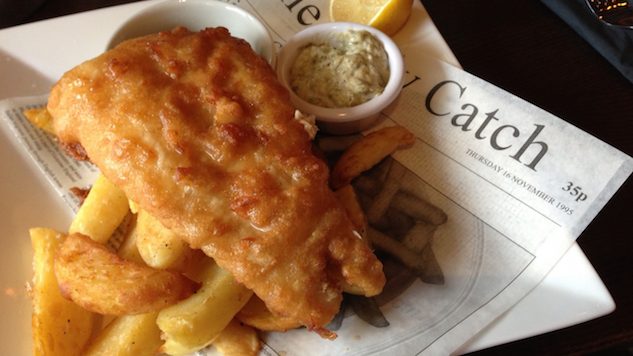Stoking the Flames of Debate: Cultural Competency in Fish and Chips
Photo by Smabs Sputzer, CC-BY
Fish and chips is a dish widely recognized to be the epitome of British fare. More than any other national dish, its contributions to history are undeniable and well-documented. It’s a working class hero, an export equally iconic as the royal family, and the dish that gave Britain its reputation as the home of brown food. During the D-Day landings, British parachuters found themselves behind enemy lines in the deep dark of night. It was impossible to tell who was a friend and who was an enemy. They developed a password that was an appropriate nod to their Britishness. One soldier would say “fish” and, if British, the other would reply “chips.” It was also one of the few foods never rationed during World War II in an effort to keep morale and patriotism up.
The history of Britain’s greatest culinary export is long and vexed, but a few milestones are agreed upon. Of course it is common for the food of immigrants to be co-opted by Anglo people all over the western world and although Britain has a longer history and richer (white) food traditions than the U.S. or Australia, this is the case even for its most iconic dish. We know that the pairing or fried fish with fried potatoes for one meal did originate in England, although the component parts had been served elsewhere in the world previously. It is well recorded that fried fish was brought to Britain by Jewish refugees from Portugal and Spain in the 17th century. In fact, Thomas Jefferson wrote about eating “fried fish in the Jewish fashion” when he visited London towards the end of the 18th century.
Most agree that the first recorded dedicated fish and chips shop was opened in London’s east end by Ashkenazi (western European) Jew Joseph Malin around 1860. At the time the area was populated with working class Jewish people and the thirteen year-old wanted to supplement his family’s income. However this is disputed, mostly by those residing in the north of England. Some believe that it was northern entrepreneur John Lees of Lancashire who opened the first fish and chip shop in 1863. He was selling fish and chips out of a wooden hut in an industrial market area. To many Brits these men’s names are unfamiliar, but the north versus south debate around fish and chips remains. A simple google search for the history of fish and chips in the United Kingdom wields results published in various reputable publications with wildly different origins. There even seems to be confusion over which Charles Dickens novel first mentioned fish and chips: Oliver Twist or A Tale of Two Cities.
There are other debates around fish and chips that carry on. The differences in opinion are rooted not just in arbitrary opinion but also in class, region and age. Presented without comment or personal opinion — and consciously adding to the huge canon of fish and chips debate pieces — below is a broad strokes, birds eye view primer:
Condiments
In the U.S. we mostly eat fish and chips with tartar sauce, or at least that was my understanding before moving to the U.K. The topping options are in fact much more nuanced. Generally, consumers choose between salt, vinegar, ketchup, brown sauce (we’ll circle back to this), mayonnaise, gravy and tartar sauce. A YouGov poll surveyed 5,334 British adults on their toppings of choice for chips (sans fish). Although any sane adult knows that a condiment for one component part may not be the same as the sum of all parts, it’s a good indicator of the variety available. In the north of England 23 percent pour gravy on their chips, compared with four percent in London. Twenty-three percent of Scots pour HP brown sauce on their chips compared with 10 percent of people from London and the rest of the south. For the uninformed, the “HP” in HP sauce stands for Houses of Parliament and the sauce tastes a little like Worcestershire sauce. Anecdotally, I like mine with a winning combination of ketchup, tartar sauce and vinegar.
-

-

-

-

-

-

-

-

-

-

-

-

-

-

-

-

-

-

-

-

-

-

-

-

-

-

-

-

-

-

-

-

-

-

-

-

-

-

-

-








































